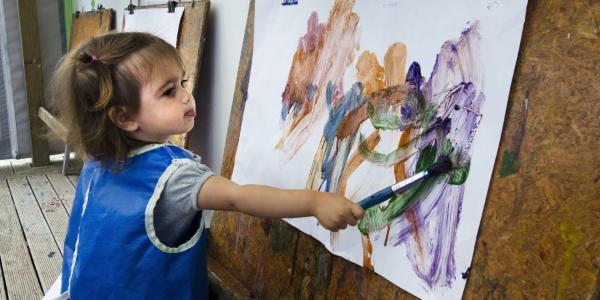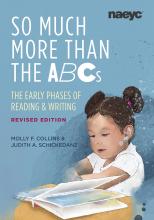So Much More than the ABCs: The Early Phases of Reading and Writing, Revised Edition

About the Book
-
A comprehensive and updated overview of what literacy development looks like for children from birth through age 5
-
Instructional approaches that support robust early language, literacy, and content knowledge learning
-
Considerations for choosing and sharing materials and for designing the physical environment in ways that support language and literacy learning
-
Recommendations for developmentally appropriate books that engage children’s minds and imaginations
-
Authentic writing samples that showcase young children’s thinking around and explorations with mark making
Table of Contents
- About the Authors
- About the Contributors
- Acknowledgments
-
Introduction: A Time to Begin
- Topics and Their Organization
- Using This Book
- This Book’s Goals
-
Part One: Building a Foundation for Reading
-
Chapter 1: What’s Involved in Learning to Read?
- Reading Processes and Phases
-
Understandings and Skills Needed When Learning to Read
- Print Conventions
- The Alphabet and Phonological Awareness
- Oral Language
-
Understandings and Skills Needed When Reading to Learn
- Decoding Skill
- Oral Vocabulary and Other Oral Language Skills
- Background Knowledge
- Reasoning
- Different Learning from Different Experiences
-
Adopting a Long View
- Looking Beyond Code-Related Skills
- Looking Beyond a Narrow Focus on Recognition-Level Oral Vocabulary
- Concluding Thoughts
-
Chapter 2: The Beginning—Reading with Infants and Toddlers | Christina M. Cassano and Jessica L. Hoffman
-
Engaging Infants and Toddlers with Reading
- From Birth to 3 Months
- From 4 to 6 Months
- From 7 to 9 Months
- From 10 to 12 Months
- From 13 to 18 Months
- From 19 to 30 Months
- Reading Daily to Older Toddlers in Groups
- Early Reading-Related Behaviors
- Concluding Thoughts
-
Engaging Infants and Toddlers with Reading
-
Chapter 3: Reading Storybooks with Preschoolers
-
Selecting Storybooks
- Interest, Cognitive Engagement, and Story Complexity
- Vocabulary and Language Structures
- Values and Diversity of Characters, Cultures, and Family Structures
-
Goals for Story Reading
- Build Community
- Support Understanding of Other People
- Build Knowledge About Emotions and Model Strategies for Regulating Them
- Support Language Development
- Build General Knowledge
-
Whole Group Story Reading
- Seating for Whole Group Story Reading
- Appropriate Book Size and Format for a Whole Group
- Thinking of the Group, Not Just Individuals
-
Comprehension: Supporting Meaning
- Story Introductions
- Voice, Gesture, Gaze, and Pacing
- Referring to Illustrations
- Comprehension Asides
- Responding to Children’s Comments and Questions During a Story
- Guiding Discussion
-
Supporting Vocabulary
- Identify Key Words
- Using Illustrations, Explanations, Gestures, and Voice
- Other Opportunities to Expose Children to a Word
-
Multiple Readings: Why Once Is Not Enough
- Introducing a Second or Third Reading
- Use of Digital Books
- Concluding Thoughts
-
Selecting Storybooks
-
Chapter 4: Sharing Informational Books with Preschoolers
- Informational Book Features and Text Formats
-
Why Read Informational Books?
- Informational Books Are Interesting
- Informational Books Support Vocabulary Development
- Informational Books Help Children Acquire Content Knowledge
- Informational Books Expose Children to Dense and Abstract Language
- Informational Books Help Children Understand Narratives
-
Contexts for Using Informational Books
- Use Informational Books in Conjunction with Storybooks
- Use Informational Books to Introduce a Small Group Experience
- Use Informational Books to Support Activities in Centers
- Include Informational Books in the Book Area
- Include Informational Books in a Lending Library
-
Strategies for Using Informational Books
- Read Only Selected Parts
- Read an Informational Book in Its Entirety
- Model the Use of Informational Text Features
-
Exposing Children to Printed Information in Nonbook Form
- Informational Print Artifacts
- Informational Magazines
- Informational Displays
- Calendars
- Concluding Thoughts
-
Chapter 5: Young Children and Literacy Skills Development
-
Alphabet Letter-Name Knowledge
- Using Children’s Names
- Additional Letter Materials
-
Phonological Awareness
- Speech Units in Words
- The Course of Phonological Awareness Acquisition
- Where to Start with Phonological Awareness
- Next Steps in Phonological Awareness Instruction
- Constructive Teacher Feedback
- Print Conventions and Functions
- Concluding Thoughts
-
Alphabet Letter-Name Knowledge
-
Chapter 1: What’s Involved in Learning to Read?
-
Part Two: Building a Foundation for Writing
-
Chapter 6: What’s Involved in Writing?
- Creating Messages
- Representing Messages
-
Phases of Writing Development
- Emergent Writing
- Beginning Conventional Writing
- More Mature Conventional Writing
-
Effective Early Childhood Practices
- Read to Young Children
- Expose Children to a Range of Purposes for Writing
- Provide Mark-Making Experiences Early
- Talk with Children About Their Writing and Drawing
- Keep the Focus on Meaning
- Understanding the Young Child’s Approach to Representing Meaning
- Concluding Thoughts
-
Chapter 7: Infants and Toddlers Leave Their Mark
- A Rationale for Early Mark-Making Experiences
-
Infants’ Actions on Objects and the Use of Mark-Making Tools
- What the Infant and Toddler Bring to These Experiences
- Mark Making Provides a New Context for Learning
-
Early Mark-Making Phases
- Phase 1: Whatever Happens, Happens
- Phase 2: Controlling and Contrasting Marks
- Phase 3: Attributing Meaning to Marks
-
Creating Accessible Mark-Making Experiences for Infants and Toddlers
- Opportunities in High Chairs
- Opportunities at Easels
- Opportunities at Water Tables and Other Places to Finger Paint
- Opportunities at Activity Tables
-
Message Content in the Making: A Look Inside the Minds of Infants and Toddlers
- Knowledge About the Behavior of Physical Objects
- Categories of Things
- Building Blocks of Communication: Emotional Expression and Identification, Emotional Understanding, and Empathy
- Concluding Thoughts
-
Chapter 8: Writing During the Preschool Years
-
Phase 1: Writing Begins to Look Like Writing and “Says” Something
- Getting into the Role of Writer
- Separating Writing and Drawing and Organizing Writing into Lines
- Attributing Meaning to Pictures
- Summing Up Phase 1
-
Phase 2: Names, Mock Words, and Detailed Pictures
- Children Write Their Names
- Interest in Words
- Pictures Become More Detailed
- Summing Up Phase 2
-
Phase 3: Writing and Drawing Come into Full Bloom
- Using Writing for a Variety of Purposes
- Making Words
- Alphabet Letter Formation
- More Complex Pictures
- Summing Up Phase 3
- Phase 4: More and More of Everything
- Concluding Thoughts
-
Phase 1: Writing Begins to Look Like Writing and “Says” Something
-
Chapter 6: What’s Involved in Writing?
- List of Children’s Literature Cited
- References
- Index
Book Details
ISBN: 978-1-952331-32-9
Publish Date: 2024
Related Resources
Articles
“Baby Steps: Using Service Learning to Integrate Art, Literacy, and Reflection with Infants and Families” - Exploring the connection between coursework and practice, Kathy Danko-McGhee and Pamela Chibucos write about how prospective educators engaged in service learning to foster art and literacy experiences in their community. (Young Children, Spring 2022)
“Design Elements in Picture Books: What They Are and Why They Are Important” - Recognizing the importance of the text itself, Jonda C. McNair and Hayley J. Hoover provide a detailed look at dust jackets, endpapers, font, and other design elements. Using multiple examples of racially and culturally diverse picture books in different genres, they showcase how children and teachers can draw meaning from design elements. (Young Children, Fall 2021)
“Talking, Reading, Singing, and Rhyming: Tips for Fostering Literacy in Infancy” - Rebecca Dowling, Lisa Shanty, Susan Sonnenschein, and Brenda Hussey-Gardner provide several tips that can be used by infant educators and shared with family members or other caregivers to help foster sensitive and responsive language and literacy interactions. (Young Children, July 2020)
Resources
Recommendations
For Authors & Photographers
Catalog
Webinars
NAEYC Books List
Services
Shop
Molly F. Collins, EdD (Boston University), associate professor of the practice of literacy in the Department of Teaching and Learning at Vanderbilt University’s Peabody College, has taught graduate and undergraduate courses in cognitive development, language acquisition, linguistics, and storybook reading. She has also provided multiyear professional learning experiences on language and literacy for preschool teachers in national and international settings. Previously, she taught toddlers and preschoolers. Collins directed early literacy and professional educator projects funded by the US Department of Education, foundations, and universities, and she served as principal investigator for foundation- and university-sponsored grants to explore monolingual and multilingual children’s vocabulary learning and comprehension from story reading. She is a member of the American Educational Research Association, the Literacy Research Association, the National Association for the Education of Young Children, and the Society for Research in Child Development, and she serves as part of the National Early Education Council at Jumpstart.

Judith A. Schickedanz, PhD (University of Illinois at Urbana-Champaign), professor emerita at Boston University, taught courses in child development, early literacy, and curriculum and instruction; served as director of the laboratory preschool; coordinated the early childhood program; and helped launch the Jumpstart volunteer program. She taught preschool and has worked extensively with early childhood teachers on funded projects, including Early Reading First. Schickedanz has authored numerous articles, book chapters, and books, including Understanding Children and Adolescents (Allyn & Bacon, 2000); Increasing the Power of Instruction (NAEYC, 2008); Writing in Preschool (International Reading Association, 2009); Inside Preschool Classrooms (Harvard Education Press, 2018); and What Are Preschoolers Thinking? (Harvard Education Press, 2022). She lives with her husband, David, in Southern California near their son’s family and enjoys their two grandchildren, a 10-year-old and a 3-year-old.

